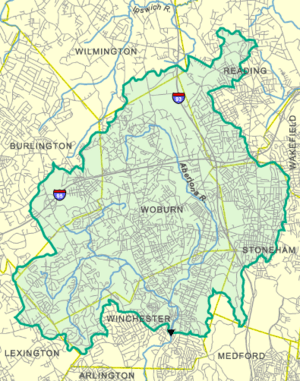Aberjona River facts for kids
Quick facts for kids Aberjona River |
|
|---|---|

The river just below the Mill Pond in Winchester center
|
|
| Country | United States |
| Physical characteristics | |
| River mouth | Mystic Lakes 7 ft (2.1 m) |
| Basin features | |
| Basin size | 25 sq mi (65 km2) |
The Aberjona River is a small river, about 9.3 miles (15 km) long. It flows through the busy northwestern suburbs of Boston, Massachusetts. The name "Aberjona" comes from the Natick language. It means "junction" or "where things meet."
Contents
Where the Aberjona River Flows
The Aberjona River begins in Reading. It then flows generally south. The river passes through Woburn and Winchester. Finally, it empties into the Mystic Lakes.
The river is usually small. It often runs through underground pipes called culverts. But in Winchester center, it becomes wider. Here, it forms Judkins Pond and the Mill Pond. The area of land that drains into the river is called its watershed. This watershed is about 25 square miles. It covers most of Woburn and about half of Winchester. It also includes parts of nearby towns like Lexington, Burlington, Wilmington, Reading, Wakefield, and Stoneham.
A Look Back at the River's History
Europeans first found the Aberjona River shortly after 1631. Captain Edward Johnson explored the area back then. The name Aberjona appeared in the very first records from the colonists. But no one knows for sure where the name came from.
By 1865, there were many leather-making shops in Woburn. These shops were called tanneries. By the 1870s, pollution from these tanneries started to harm the river. It also affected the Upper Mystic Lake, which was a source of drinking water. Because of this, the Massachusetts Legislature made rules. They banned dumping waste into Horn Pond Brook in 1907. They also banned dumping waste into the Aberjona River in 1911.
Protecting the River: Pollution and Cleanup
A study in 1995 looked at the dirt at the bottom of the Upper Mystic Lake. This study found high levels of certain metals. These metals included arsenic, cadmium, chromium, copper, lead, and zinc. Records from industries showed that chemical and leather factories had put these substances into the water since the early 1900s.
The 'A Civil Action' Story
The Aberjona River was part of a famous true story. This story became a bestseller book in 1995 called A Civil Action. Later, it was made into a movie in 1998. In the story, people said that workers from nearby factories dumped harmful chemicals. They put these chemicals into trenches very close to the river. People remembered that the Aberjona River used to be "clear and full of fish."
The Industri-plex Site
From 1969 to the early 1980s, a large industrial area called Industri-plex was built along the river. This area was close to major highways. Factories at Industri-plex added to the pollution in the area. They used many chemicals for making paper, textiles, and leather. These chemicals included lead-arsenic insecticides, acetic acid, benzene, toluene, and sulfuric acid. Today, Industri-plex is a "superfund" site. This means it was a very polluted place that the government helps clean up. Most of the cleanup work has now been done.


